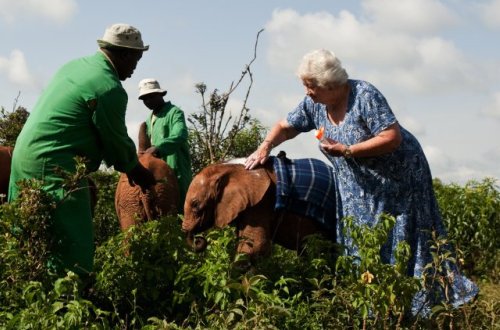Review: Born to Be Wild

While growing up in the late Sixties to early Seventies, one of the favorite television shows in our house was Mutual of Omaha's Wild Kingdom with host Marlin Perkins. We loved watching wild animals in their natural habitat along with the challenges faced by Perkins and his field correspondents Jim Fowler and Peter Gros. Similar in nature was the classic film Born Free (1966), which told the story of female lion cub Elsa raised to maturity by a Kenyan game warden. Elsa is re-educated so that she can be released back into the wild. Both Wild Kingdom and Born Free left out the violence experienced in the wild, a pattern followed by IMAX documentary Born to Be Wild.
Directed by David Lickley and narrated by Morgan Freeman, Born to Be Wild focuses on two inspirational women, primatologist Birute Galdikas and elephant expert Daphne Sheldrick, who both work with orphaned animals to re-educate and release them into the wild. Galdikas works with orangutans in the rainforests of Borneo who have been orphaned as a result of clear-cutting, while Sheldrick rescues young elephants in Kenya whose mothers are killed by poachers. In both situations, staff help to fill the maternal and family void that help the orphans survive. Their shared mission is to rescue, rehabilitate and return these animals safely back to the wild. The scenes of young orangutans playing and a young elephant sleeping with his keeper are heartwarming.
Born to be Wild isn't the first film treatment of Sheldrick's elephants -- the 1979 documentary Bloody Ivory follows the more tragic and violent nature of the struggle in Kenya’s Tsavo National Park against bow-and-arrow poachers who kill elephants and rhino, and the story of David and Daphne Sheldrick's efforts of hand-rearing elephant and rhino orphans. David died in 1977, and Daphne's dealt with the loss of her husband by creating the David Sheldrick Wildlife Trust to continue their work. Galdikas was also not always a wildlife rehabilitator -- at the age of 25, Galdikas arrived in Borneo to begin her field studies of orangutans in a jungle environment after being hand-picked by famed paleontologist Louis Leakey. She remained in Borneo for over 30 years and founded the organization Orangutan Foundation International,which focuses on conservation efforts and rehabilitation.
Born to be Wild director David Lickley is well-accustomed to nature documentaries, having directed Jane Goodall's Wild Chimpanzees (2002) and the IMAX short film Bears (2004). The cinematography is stunning, from the lush rainforest to the many hues of the Kenyan savannah. With over 35 years of IMAX film experience, director of photography David Douglas helped the IMAX camera team develop a new digital 3D IMAX camera prototype to address some of the limitations faced by wildlife filmmakers. The new lighter and quieter camera weighs approximately a quarter of the IMAX film camera’s 300-pound weight, which allows the camera to be used in places and situations that were difficult before. It also allows for more natural ambient sounds to be captured and is less obtrusive to the animals in their natural habitat. The final results are amazing, with some incredible close shots of the animals.
For the general public who enjoy IMAX nature films, Born to be Wild will appeal. This lighthearted documentary is perfectly suited for the IMAX theater, but at only 40 minutes Born to Be Wild lacks any real substance to have any staying power. If you want to get to the heart of the film including educational messages and call to action, save the price of admission and visit the film's official website instead. Kids will love the interactive format, and there are even downloadable activities for teachers.

